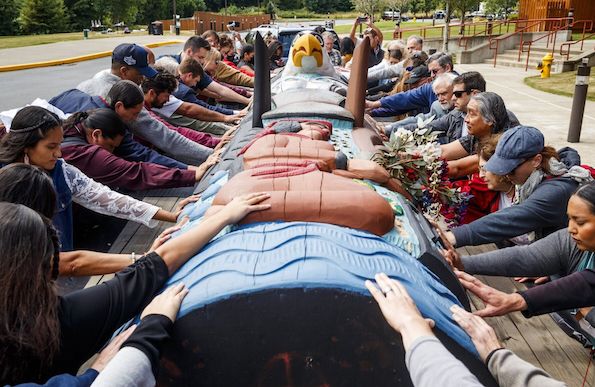forum
library
tutorial
contact

Salmon Restoration is a Matter
of Ecological, Cultural Survival
by Claudia Kauffman
Seattle Times, June 12, 2023
|
the film forum library tutorial contact |

|
Salmon Restoration is a Matter
by Claudia Kauffman
|
More must be done to make breaching
the dams a reality before it's too late.
 The journey toward breaching the four Lower Snake River Dams in the Columbia Basin has become a focal point in our collective efforts to restore salmon populations, honor Indigenous sovereignty and revive our cultural heritage.
The journey toward breaching the four Lower Snake River Dams in the Columbia Basin has become a focal point in our collective efforts to restore salmon populations, honor Indigenous sovereignty and revive our cultural heritage.
The dams -- Ice Harbor, Lower Monumental, Little Goose and Lower Granite -- have had a significant impact on salmon runs and the Nez Perce way of life, as well as other Pacific Northwest tribes. These dams, built decades ago for various purposes, have disrupted the natural migration patterns of salmon, leading to a decline in their populations and threatening the cultural practices and traditions that are deeply intertwined with these magnificent fish.
For the Nez Perce Tribe -- my tribe -- the breaching of the four Lower Snake River Dams is not merely an environmental concern; it is a matter of cultural survival. Salmon are the lifeblood of our people, providing nourishment, spiritual connection and a sense of identity as the Salmon People. We fought to ensure our rights to fish were included in the treaties of the 1850s. A century later, we fought yearslong Fish Wars to preserve those rights. Restoring their populations is not only an ecological imperative but also a means to revitalize our cultural practices and ensure the transmission of our traditions to future generations.
In our pursuit of salmon restoration and cultural resurgence, co-management has played a vital role. By collaborating with Indigenous communities, governmental agencies and other stakeholders, we recognize the importance of shared responsibility in protecting and managing our natural resources. Co-management allows us to integrate traditional knowledge with scientific research and policymaking processes, ensuring that decisions are rooted in a holistic and inclusive approach.
Breaching the dams is not without its challenges. It requires a careful balance of environmental stewardship, economic considerations and the preservation of existing infrastructure.
However, the progress we made during the 2023 session gets us closer to realizing our shared goals.
The state Legislature and Gov. Jay Inslee authorized more than $7 million in funding to develop plans to replace the energy, transportation and irrigation services currently provided by the four aging Lower Snake River Dams, as well as $36 million for salmon habitat and recovery. My colleagues and I also utilized funds from the Climate Commitment Act to reduce salmon passage barriers and protect and recover salmon and other keystone species in nearshore marine waters. Federal dollars from the recent infrastructure and inflation reduction acts are improving habitat and opening fish passage throughout the region too, along with efforts from U.S. Sen. Patty Murray.
But we know more must be done to make breaching the dams a reality before it's too late.
As we move forward, it is essential to maintain open dialogue, prioritize scientific research and respect the traditional knowledge held by Indigenous communities. By continuing to embrace co-management principles, we can navigate the complexities of dam-breaching, mitigate potential impacts and ensure the long-term sustainability of our river systems.
Together, we can forge a future where healthy salmon runs thrive in the Snake River and Columbia Basin, Indigenous sovereignty is respected and celebrated, and the cultural heritage of the Nez Perce Tribe and other Indigenous communities remains vibrant and resilient.
learn more on topics covered in the film
see the video
read the script
learn the songs
discussion forum
